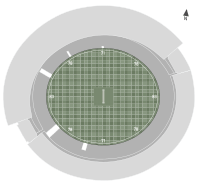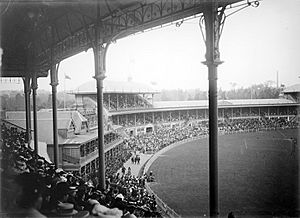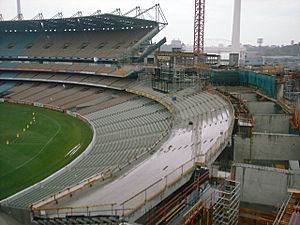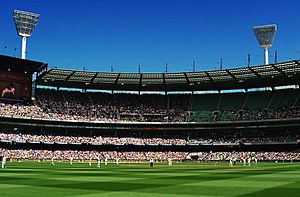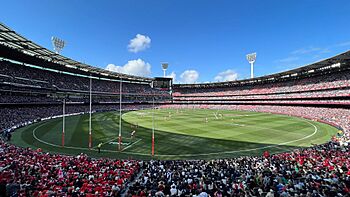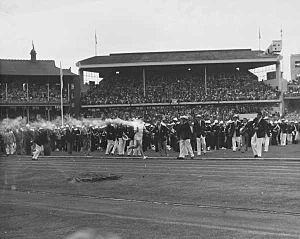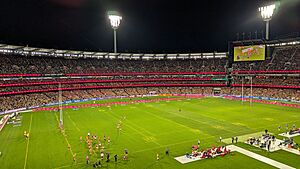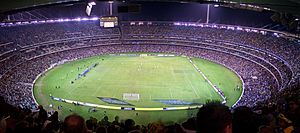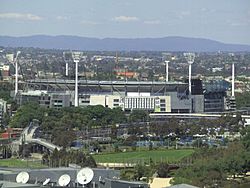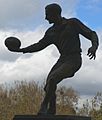Melbourne Cricket Ground facts for kids
|
MCG, the 'G
|
|||||||||||||||||||||||||||||||||||||
 |
|||||||||||||||||||||||||||||||||||||
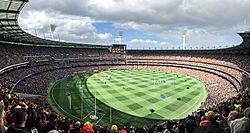
Panorama of the MCG before
the 2017 AFL Grand Final |
|||||||||||||||||||||||||||||||||||||
| Address | 120 Brunton Avenue | ||||||||||||||||||||||||||||||||||||
|---|---|---|---|---|---|---|---|---|---|---|---|---|---|---|---|---|---|---|---|---|---|---|---|---|---|---|---|---|---|---|---|---|---|---|---|---|---|
| Location | East Melbourne, Victoria, Australia | ||||||||||||||||||||||||||||||||||||
| Coordinates | 37°49′12″S 144°59′0″E / 37.82000°S 144.98333°E | ||||||||||||||||||||||||||||||||||||
| Public transit | |||||||||||||||||||||||||||||||||||||
| Owner | Victoria State Government | ||||||||||||||||||||||||||||||||||||
| Operator | Melbourne Cricket Club (MCC) | ||||||||||||||||||||||||||||||||||||
| Executive suites | 109 | ||||||||||||||||||||||||||||||||||||
| Capacity | 100,024 (95,000 seats + 5,000 standing room) | ||||||||||||||||||||||||||||||||||||
| Record attendance |
|
||||||||||||||||||||||||||||||||||||
| Field size | 174 metres x 149 metres (general) 160 metres x 141 metres (AFL) 172.9 metres x 147.8 metres (cricket) |
||||||||||||||||||||||||||||||||||||
| Surface | Grass | ||||||||||||||||||||||||||||||||||||
| Construction | |||||||||||||||||||||||||||||||||||||
| Opened | 1853 | ||||||||||||||||||||||||||||||||||||
| Renovated | 1992 (Southern Stand redevelopment) 2006 (Northern Stand redevelopment) 2032 (Proposed Shane Warne Stand redevelopment) |
||||||||||||||||||||||||||||||||||||
| Construction cost | An estimated $725 million AUD (excluding the original 1853 construction) |
||||||||||||||||||||||||||||||||||||
| Tenants | |||||||||||||||||||||||||||||||||||||
|
Melbourne Football Club (1858–present)
Australian cricket team (1877–present) Melbourne Storm (2000)
Australia men's national soccer team (selected matches)
|
|||||||||||||||||||||||||||||||||||||
|
|||||||||||||||||||||||||||||||||||||
|
|||||||||||||||||||||||||||||||||||||
The Melbourne Cricket Ground (MCG), also known as the 'G, is a huge sports stadium in Melbourne, Victoria, Australia. It's managed by the Melbourne Cricket Club. The MCG is the biggest stadium in the Southern Hemisphere. It's also the eleventh-largest stadium in the world and the second-largest for cricket.
You can easily walk to the MCG from Melbourne's city center. It's also close to Richmond and Jolimont train stations. Trams on routes 70, 75, and 48 also stop nearby. The stadium is right next to Melbourne Park, making it a key part of Melbourne's sports area.
Built in 1853, the MCG has been updated many times. It was the main stadium for the 1956 Summer Olympics and the 2006 Commonwealth Games. It also hosted two Cricket World Cup finals in 1992 and 2015. The MCG is famous for its role in cricket history. It held the first ever Test match and the first One Day International game. Both were between Australia and England in 1877 and 1971.
The stadium has strong ties to Australian rules football since 1859. It's the main place for Australian Football League (AFL) games, including the AFL Grand Final. This final is the most-watched league championship event in the world.
The MCG is home to the Australian Sports Museum. It has also hosted other big sports events. These include international rules football games, rugby union matches, State of Origin (rugby league) games, and FIFA World Cup qualifiers. Many concerts and cultural events happen here too. The record for attendance at any event was 143,750 people for a Billy Graham event in 1959.
Today, the stadium can seat about 95,000 people, with room for 5,000 standing. This brings the total capacity to 100,024. The MCG is listed on the Victorian Heritage Register and the Australian National Heritage List. In 2003, a journalist called it "a shrine, a citadel, a landmark, a totem" that "symbolises Melbourne to the world."
Contents
- Stadium History & Development
- Cricket at the MCG
- Australian Rules Football
- American Football
- World War II Use
- Olympic Games Host
- Commonwealth Games
- Rugby Union Matches
- Rugby League Matches
- Soccer Matches
- Concerts and Events
- Other Uses
- MCG Records
- Cricket Player Records
- Statues of Sporting Legends
- See also
Stadium History & Development

The MCG was built on land once used by the Wurundjeri people for camping and gatherings. The Melbourne Cricket Club (MCC) chose this spot in 1853. Before this, they played at several other locations around Melbourne. The club's first game was against a military team in 1838.
The MCC moved a few times due to new developments like the railway. In 1853, the Governor offered the MCC three new sites. They chose the Richmond Park area, which is where the MCG is today. This spot was flat enough for cricket but also sloped to prevent flooding.
In 1861, a group of trustees was put in charge of the ground. For many years, the MCC had a lot of control over the stadium. But in 1906, the government appointed more trustees, giving them more say. The government still oversees the trust today.
When the land was first given, it was only for cricket. This rule changed in 1933, allowing other uses. New laws in 1989 and 2009 further updated these rules.
Building the Grandstands
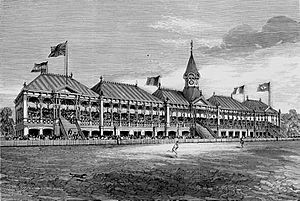
The first wooden stand for members was built in 1854. A temporary public stand with 6,000 seats was added in 1861. In 1876, another stand was built for 2,000 people. This was for the English cricket team's visit in 1877, when the MCG hosted the world's first Test match.
In 1881, a new brick stand replaced the old members' stand. It was considered the best cricket facility in the world. A telephone was installed, and the playing direction was changed. A scoreboard was also added to show player details.
More stands were built in the early 1900s, increasing capacity to nearly 20,000 seats. The total ground capacity reached almost 60,000. In 1927, the second brick members' stand was replaced. The Southern Stand opened in 1936, seating 18,200 under cover. The stadium's maximum capacity was then 94,000 people.
The Northern Stand, also called the Olympic Stand, was built for the 1956 Summer Olympics. This increased the stadium's capacity to 120,000. In 1968, the Western Stand was completed and later renamed the W.H. Ponsford Stand. The highest attendance for a sporting event, 121,696, was set in 1970.
In 1982, the MCG got Australia's first full-color video scoreboard. Light towers were installed in 1985, allowing night games. The old Southern Stand was replaced by the Great Southern Stand in 1992. This cost $150 million and was ready for the 1992 Cricket World Cup. It was renamed the Shane Warne Stand in 2022.
Between 2003 and 2005, the 1928 Members' stand, 1956 Olympic stand, and 1968 W.H. Ponsford stand were replaced. A new structure was built for the 2006 Commonwealth Games. This redevelopment cost over $400 million and brought the capacity to just over 100,000. The highest attendance since then was 100,024 at the 2022 AFL Grand Final and 2023 AFL Grand Final.
From 2011 to 2013, the Great Southern Stand had a $55 million upgrade. This improved gates, food outlets, and other facilities. New, larger scoreboards were installed in late 2013. From 2019 to 2020, all stadium lights were replaced with LED lighting.
Cricket at the MCG
The first cricket match at the MCG was on September 30, 1854. The first inter-colonial match was between Victoria and New South Wales in March 1856. Early games had some arguments, but cricket quickly became popular.
In 1861, an English cricket team visited Australia. Their first game at the MCG on New Year's Day 1862 drew about 25,000 people. This was the largest crowd to ever watch a cricket match anywhere in the world at that time.
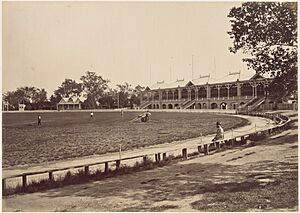
The First Test Match
In 1877, the MCG hosted the first ever Test match between Australia and England. Australia won by 45 runs. Charles Bannerman scored 165 runs for Australia. Two years later, Fred Spofforth took the first hat-trick in Test cricket at the MCG.
Cricket Today
The MCG has been a major Test venue for over a century. Since 1982, it has hosted one Test match every summer. The Boxing Day Test, starting on December 26, is a famous annual event. The stadium also hosts one-day and Twenty20 international matches.
The Victorian first-class team plays Sheffield Shield cricket here. The Melbourne Stars club plays its home matches in the Big Bash League (BBL). The Melbourne Stars Women team also plays here in the Women's Big Bash League (WBBL).
The MCG used to have a natural pitch, but it caused problems. Since 1996, drop-in pitches have been used, offering more consistent play. New drop-in pitches were ready for use by the early 2020s.
Famous Cricket Moments
In 1926–27, Victoria scored 1107 runs in two days against New South Wales. This is the highest first-class team score ever. Bill Ponsford scored 352 runs and Jack Ryder scored 295.
The first One Day International match was played at the MCG on January 5, 1971. Australia beat England by 5 wickets. In March 1977, a Centenary Test Match celebrated 100 years since the first Test. Australia won by the same margin of 45 runs.
A famous incident happened in 1981 during a match between Australia and New Zealand. Australian captain Greg Chappell told his brother Trevor to bowl the last ball underarm. This prevented New Zealand from hitting a six to tie the game. The rules of cricket were changed after this to stop it from happening again.
The MCG hosted the 1992 Cricket World Cup Final, where Pakistan beat England. In 2015, Australia won the 2015 Cricket World Cup Final against New Zealand with 93,013 fans watching. The 2020 ICC Women's T20 World Cup Final also set a record for women's cricket attendance with 86,174 people.
| Number | Teams | Match type | Attendance | Date |
|---|---|---|---|---|
| 1 | Australia v New Zealand | 2015 Cricket World Cup Final (ODI) | 93,013 | 29 March 2015 |
| 2 | Australia v England | Test | 91,112 | 26 December 2013 |
| 3 | Australia v West Indies | Test | 90,800 | 11 February 1961 |
| 4 | India v Pakistan | 2022 Men's T20 World Cup (Super 12) | 90,293 | 23 October 2022 |
| 5 | Australia v England | Test | 89,155 | 26 December 2006 |
Australian Rules Football
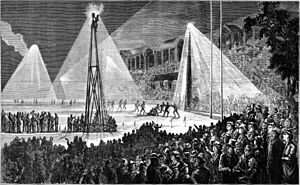
Even though it's called the Melbourne Cricket Ground, it's used more often for Australian rules football. Football games bring in more spectators and money than any other sport at the MCG.
The first recorded football match at the ground was in 1858. It was played between Melbourne Grammar and Scotch College. In 1879, the first official football match was played on the MCG. Two night matches were also played that year using new electric lights.
The Melbourne Football Club, Australia's oldest club, used the MCG as its home ground. They won five championships in the 1870s. The first VFL/AFL game at the MCG was on May 15, 1897.
Grand Finals and Records
The AFL Grand Final has been played at the MCG almost every year since 1902. Exceptions were during World War II, in 1991 due to construction, and in 2020 and 2021 due to the COVID-19 pandemic.
Before the stadium had all seats, grand finals could draw over 110,000 people. The record for the highest attendance in the sport's history is 121,696 at the 1970 VFL Grand Final.
Today, grand final attendances are usually between 95,000 and 100,000. The record since seating was added is 100,024, set at the 2022 AFL Grand Final and 2023 AFL Grand Final. The MCG is set to host the grand final every year until 2059.
Many Melbourne-based AFL teams play their home games at the MCG. These include Melbourne Football Club, Richmond Football Club, Essendon Football Club, Collingwood Football Club, Hawthorn Football Club, and Carlton Football Club.
American Football
The National Football League (NFL) announced a deal in February 2025. This deal will bring multiple regular season NFL games to Melbourne. The NFL Melbourne Games will start at the MCG in 2026. The Los Angeles Rams will be the home team for the first game.
World War II Use
During World War II, the government took over the MCG for military use. From 1942 to 1945, it housed over 200,000 military personnel. The United States Army Air Forces called it "Camp Murphy" in 1942. In 1943, the First Regiment of the First Division of the US Marine Corps used the ground to rest.
Olympic Games Host
The MCG's most famous moment was being the main stadium for the 1956 Summer Olympics. It hosted the opening and closing ceremonies, track and field events, and finals for field hockey and soccer. The stadium's capacity was increased to 103,000 for the Games.
A young runner named Ron Clarke carried the Olympic torch into the stadium. He later became a very famous distance runner. Australian sprinter Betty Cuthbert won three gold medals at the MCG during these Games. She won the 100m, 200m, and was part of the winning 4 x 100m relay team. Shirley Strickland also won gold in the 80m hurdles.
The MCG also hosted an exhibition game of baseball. An estimated 114,000 people watched, setting a Guinness World Record at the time. It also hosted a demonstration game of Australian Rules Football.
The MCG's Olympic history continues today. The Australian Gallery of Sport and Olympic Museum is located inside the stadium. In 2000, the MCG hosted some soccer preliminary matches for the 2000 Summer Olympics in Sydney.
Commonwealth Games
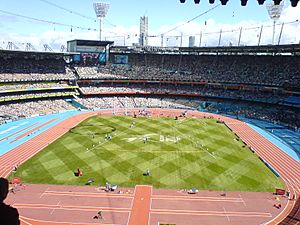
The Opening and Closing Ceremonies of the 2006 Commonwealth Games were held at the MCG. It also hosted the athletics events. The games ran from March 15 to March 26.
The stadium's seating capacity for the games was 80,000. Australia won the most medals in athletics. Eleven Games records were broken during the competition.
Rugby Union Matches
The first Rugby union game at the MCG was on June 29, 1878. The Waratah Club of Sydney played Carlton Football Club. Rugby matches were played occasionally over the years.
In 1997, the MCG hosted a Test match between Australia and New Zealand. It drew a crowd of 90,119. Australia and New Zealand played again in 1998 and 2007. In 2023, Australia played New Zealand again, with 83,944 people attending.
In July 2025, Australia played the British and Irish Lions at the MCG. The Lions won 26–29 in front of 90,307 fans. This was the largest ever crowd for a British & Irish Lions match and the MCG's biggest rugby union crowd.
Rugby League Matches
Rugby league was first played at the MCG on August 15, 1914. The New South Wales team lost to England.
The first State of Origin match at the MCG was in 1994. It set a new record for a rugby league crowd in Australia with 87,161 people. The MCG also hosted State of Origin games in 1995, 1997, 2015, 2018, and 2024. The 2015 game set an all-time record State of Origin crowd of 91,513. The 2024 game had 90,084 spectators.
Soccer Matches
The MCG hosts world-class soccer events. In May 2006, Australia played European champions Greece in front of 95,103 fans. Australia won 1–0. The Socceroos also played Argentina in 2007 and Japan in 2009.
Other notable soccer matches include:
- The Olympic final in 1956 between the USSR and Yugoslavia.
- A 1998 FIFA World Cup qualifier between Australia and Iran in 1997, with 95,000 people attending.
- A friendly match between Manchester United and Australia in 1999.
- An Olympic Tournament group match between Italy and the Olyroos in 2000, with 93,252 fans.
- A friendly match between Melbourne Victory and Liverpool in 2013, drawing 95,446 people.
- The final of the 2015 International Champions Cup between Real Madrid and Manchester City, which set a soccer record for the MCG with 99,382 fans.
- A friendly between Newcastle United F.C. and Tottenham Hotspur F.C. in May 2024.
Concerts and Events
The MCG is a popular place for concerts. The first rock concert was by David Cassidy in 1974. David Bowie played there in 1978. In 1993, Paul McCartney, U2, and Madonna held concerts, selling 147,241 tickets.
Other famous artists who have played at the MCG include The Rolling Stones, Michael Jackson, Elton John, and Billy Joel. In 2009, Sound Relief, a charity concert for bushfire victims, had 80,518 attendees.
Guns N' Roses played concerts in 2017 and 2022. Eminem's concert in 2019 sold 80,708 tickets, his biggest show ever at the time. Ed Sheeran broke this record in March 2023 with 109,500 people at one of his concerts.
Taylor Swift held three concerts in February 2024, with 96,000 people each night. This set a record for the most tickets sold by one artist at the venue. AC/DC announced two concerts for November 2025.
Other Uses
Tennis and Cycling
In 1878, the first game of tennis in Victoria was played at the MCG. The first Victorian Championship was held there in 1880. In 1869, one of Australia's first bicycle races took place at the MCG.
Miscellaneous Events
- Queen Elizabeth II visited the MCG in 1954 and 2006.
- Religious leader Billy Graham set an attendance record of 143,000 people in 1959.
- Pope John Paul II held a service at the MCG in 1986.
- The MCG hosted WWE Super Show-Down in 2018.
- A state memorial service for Shane Warne was held there in 2022.
MCG Records
Sporting Firsts
- First ever Test Cricket match (Australia v England) – 1877
- First ever One Day International Cricket match – 1971
- Highest first-class cricket score – 1107 (Victoria v NSW, 1926)
Attendance Records
| Number | Attendance | Event | Date |
|---|---|---|---|
| 1 | 143,000 | Billy Graham, Crusade | 15 March 1959 |
| 2 | 121,696 | VFL Grand Final, Carlton v Collingwood | 26 September 1970 |
| 3 | 120,000 | 40th Eucharistic Congress | 25 February 1973 |
| 4 | 119,195 | VFL Grand Final, Carlton v Richmond | 27 September 1969 |
| 5 | 118,192 | VFL Grand Final, Hawthorn v St Kilda | 25 September 1971 |
- Highest VFL/AFL Grand Final attendance – 121,696 (Collingwood v Carlton, 1970)
- Highest soccer crowd (club match) – 99,382 (Manchester City v Real Madrid, 2015)
- Highest soccer crowd (national teams) – 97,103 (Australia v Greece, 2006)
- Highest single-day Test Cricket attendance – 91,092 (Australia v England, 2013)
- Highest One Day International Cricket crowd – 93,013 (Australia v New Zealand, 2015)
- Highest Twenty20 International Cricket crowd – 90,293 (India v Pakistan, 2022)
- Highest women's cricket crowd - 86,174 (Australia Women v India Women, 2020)
- Highest State of Origin rugby league crowd – 91,513 (New South Wales v Queensland, 2015)
- Highest rugby union crowd – 90,307 (British & Irish Lions v Australia, 2025)
Stadium Innovations
- World's first all-color cricket scoreboard with instant replays.
- World's first electronic sight screens.
- World's first super sopper (a machine to dry the ground).
- World's first scrolling signs at an oval-shaped ground.
- First time an international cricket match was played on a portable pitch (Boxing Day Test, 2000).
- World's tallest floodlights.
Cricket Player Records
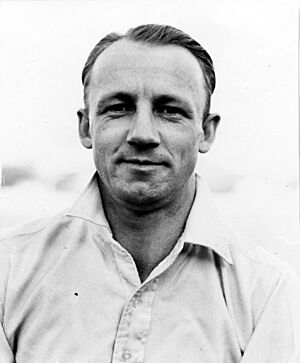
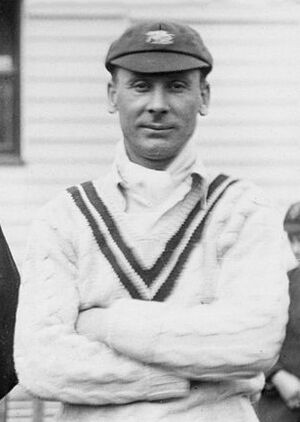
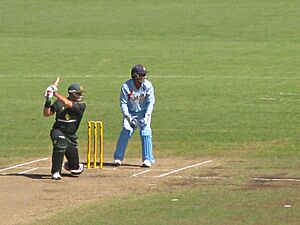
Batting Records (Test Cricket)
| Runs | Player | Period |
|---|---|---|
| 1,671 | 1928–1948 | |
| 1,338 | 1995–2011 | |
| 1,178 | 1908–1929 |
| Runs | Player | Date |
|---|---|---|
| 307 v. England | 11 Feb 1966 | |
| 270 v. England | 1 Jan 1937 |
| Centuries | Player | Period |
|---|---|---|
| 9 | 1928–1948 | |
| 6 | 1996–2008 |
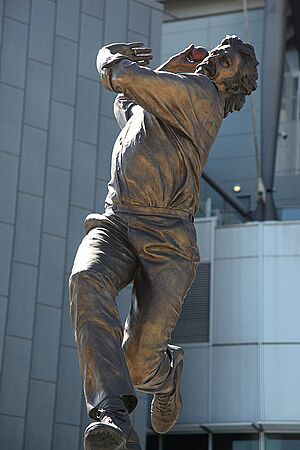
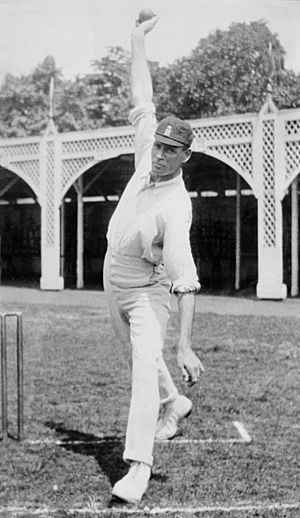
Bowling Records (Test Cricket)
| Wickets | Player | Period |
|---|---|---|
| 82 | 1972–1983 | |
| 56 | 1992–2006 | |
| 35 | 1902–1912 |
| Figures | Player | Date |
|---|---|---|
| 9/86 v. Australia | 10 Mar 1979 | |
| 9/121 v. England | 11 Feb 1921 |
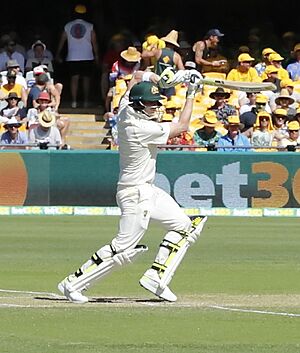
Team Records (Test Cricket)
| Score | Team | Date |
|---|---|---|
| 8/624d | 26 Dec 2016 | |
| 604 | 26 Feb 1937 |
| Score | Team | Date |
|---|---|---|
| 36 | 12 Feb 1932 | |
| 45 | 12 Feb 1932 |
Statues of Sporting Legends
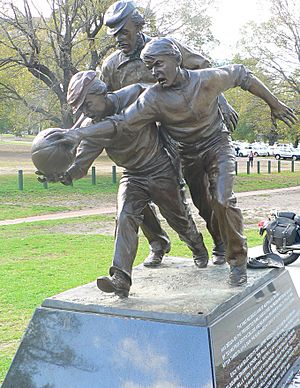
The MCG has many statues of famous sportspeople around its grounds. These statues celebrate the athletes who have competed here.
Parade of Champions
The "Tattersall's Parade of Champions" is a collection of statues given to Australia. They highlight the connection between top athletes and the MCG.
| Statue | Sport | Unveiled | Location |
|---|---|---|---|
| Sir Donald Bradman | Cricket | 2003, May | Outside gate 5 |
| Betty Cuthbert | Track and field | 2003, August | Outside gate 3 |
| Ron Barassi | Australian rules football | 2003, September | Outside gate 4 |
| Keith Miller | Cricket | 2004, February | Outside gate 5 |
| Dick Reynolds | Australian rules football | 2004, June | Outside gate 6 |
| Shirley Strickland | Track and field | 2004, November | Outside gate 3 |
| Leigh Matthews | Australian rules football | 2005, August | Outside gate 4 |
| Dennis Lillee | Cricket | 2006, December | Outside gate 1 |
Avenue of Legends

The "Australia Post Avenue of Legends" is another group of statues. These statues are placed in Yarra Park, leading towards Wellington Parade. The most recent addition, Kevin Bartlett, was unveiled in March 2017.
| Statue | Sport | Unveiled | Location |
|---|---|---|---|
| Shane Warne | Cricket | 2011, December | Outside gate 2 |
| Norm Smith | Australian rules football | 2012, September | Near Jolimont Station |
| John Coleman | Australian rules football | 2013, September | Outside gate 2 |
| Neil Harvey | Cricket | 2014, January | Near Jolimont Station |
| Jim Stynes | Australian rules football | 2014, September | Outside gate 2 |
| Kevin Bartlett | Australian rules football | 2017, March | Near Jolimont Station |
See also
 In Spanish: Melbourne Cricket Ground para niños
In Spanish: Melbourne Cricket Ground para niños


